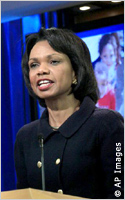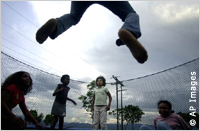GLOBAL HEALTH | Addressing the world’s health challenges
12 January 2009
Bush’s Successful HIV/AIDS Program Looks to Next Five Years
PEPFAR is first major effort aimed at developing-world chronic disease

Washington — During its first five years, from 2003 to 2008, the President’s Emergency Plan for AIDS Relief (PEPFAR) exceeded its goals of supporting treatment for 2 million HIV-infected people and care for 10 million people living with HIV/AIDS, including orphans and vulnerable children.
The program’s 2009 annual report to Congress, Celebrating Life, details PEPFAR successes and the breaking of new ground in becoming the first large-scale effort to tackle a chronic disease in the developing world.
“In 2003, when President George W. Bush announced PEPFAR, many still doubted whether HIV prevention, care and treatment services could ever be provided in a resource-limited setting, where HIV/AIDS was a death sentence,” Secretary of State Condoleezza Rice said January 12 during a briefing at the State Department in Washington to release the report.
“Just five years later,” she added, “thanks to strong partnerships between the American people and the people of host nations around the world, we've seen what was once thought to be impossible become truly possible.”
HISTORIC INITIATIVE
With an original commitment of $15 billion over five years and a final funding level of $18.8 billion, PEPFAR is the largest international health initiative in history dedicated to a single disease and the world’s largest development initiative.
In 2008, Bush signed into law a document that authorizes up to $48 billion over the next five years to fight global HIV/AIDS, tuberculosis and malaria. (See “U.S. Law Extends Global Assistance for HIV/AIDS by Five Years.”)
Through 2013, PEPFAR will work in partnership with host nations to treat at least 3 million people, prevent 12 million new infections and care for 12 million people, including 5 million orphans and vulnerable children, the report says.
The program also will support training for at least 140,000 new health care workers in HIV/AIDS prevention, treatment and care, according to the report.

“As we leave office,” Rice said, “I don't think that anything will stand as strongly, in the hearts and minds of people around the world but also in our own consciousness, as the work and the achievements of PEPFAR.”
CARE, TREATMENT, PARTNERSHIPS
Through September 30, 2008, PEPFAR funding supported life-saving treatment for more than 2.1 million men, women and children worldwide, including more than 2 million in the 15 focus countries — Botswana, Cote d'Ivoire, Ethiopia, Guyana, Haiti, Kenya, Mozambique, Namibia, Nigeria, Rwanda, South Africa, Tanzania, Uganda, Vietnam and Zambia.
“PEPFAR is not only a bilateral program, it’s also a multilateral program,” Dr. Mark Dybul, the U.S. global AIDS coordinator, said during the briefing. “The United States is the largest contributor to the Global Fund to Fight AIDS, Tuberculosis and Malaria” — a global public-private partnership — “so about 30 percent of every Global Fund grant comes from the American people through PEPFAR.”
PEPFAR support for treatment will save an estimated 3.28 million adult years of life through the end of September 2009, and the program increased the share of treated children from 3 percent in 2004 to 8 percent in 2008, the report says.
The program supported care for more than 10.1 million people affected by HIV/AIDS worldwide, including more than 4 million orphans and vulnerable children; HIV counseling and testing for nearly 57 million people; and tuberculosis treatment for more than 395,400 HIV-infected patients, the report says.
In 2008, PEPFAR partnered with 2,667 organizations, 86 percent of them local, up from 1,588 in 2004. The program also supported, according to the report, an estimated 3.7 million training and retraining encounters for health care workers between 2004 and 2008.
Asked about the future of PEPFAR, Dybul said that President-elect Barack Obama was one of 16 co-sponsors of the program in the Senate; Vice President-elect Joe Biden helped move the bill through the Senate.
“So clearly there’s strong support” for PEPFAR in the next administration, Dybul said.
A transcript of remarks by Rice and a transcript of remarks by Dybul are available on America.gov.
The full text of the report is available on the State Department Web site.
